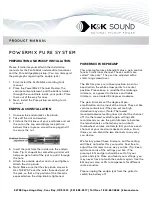
Model No. PS-2152
Factors That May Affect Results
7
®
Factors That May Affect Results
In your graphs of Total Flow and Lung Volume, you may notice a slow
drift or slight fluctuation in the baseline. These can be eliminated, in most
cases, as described below. Note that slow baseline changes usually do not
significantly affect the measurements of volumes and capacities that you
take from the graphs.
•
Air pressure changes in the environment during the measurement
period can influence the sensor readings. Sources of such pressure
changes include doors opening or closing, heating/cooling/ventilation
systems starting or stopping, and air movement within the testing room.
In most cases environmental pressure variation is tolerably low over
the typical 30-second test period.
•
The sensor calculates Total Flow by integrating the measured Flow
Rate over time. Because of this time integration, a very small offset in
the Flow Rate measurement may result in a noticeable upward or
downward trend in the baseline of the Total Flow (or Lung Volume)
data. This trend usually does not have a significant effect on the volume
and capacity measurements taken from the graph, since each
measurement is made between two data points recorded within a few
seconds. In DataStudio you can eliminate the trend with this
calculation:
Total Flow = integral((1 - inrange(0, .03, abs(smooth(10, R)))) * R)
Define R as the Flow Rate. Use the calculated data in place of the data
directly from the sensor. If the trend is still apparent, increase the “.03”
parameter so that it is slightly larger than Flow Rate offset.
Troubleshooting
Problem
Solutions
Drift or fluctuation
in the baseline of
Total Flow or Lung
Volume
Slow drift (less than 0.3 L in 30 s) is insignificant and can be ignored.
Protect the mouthpiece from movement, air currents and pressure
changes while the WAIT indicator is blinking.
Do not move the electronics enclosure during the entire test.
Use the calculation described above.
Large shift in
baseline of Total
Flow or Lung
Volume after forced
expiration
Use a nose clip or have the subject pinch his or her nose to prevent
airflow through the nose.
Ensure a good seal of the subject's lips around the mouthpiece.
Replace the mouthpiece with an unused one.
Unrealistically high
Total Flow or Flow
Rate readings
Protect the mouthpiece from movement, air currents and pressure
changes while the WAIT indicator is blinking.
Replace the mouthpiece with an unused one.


























